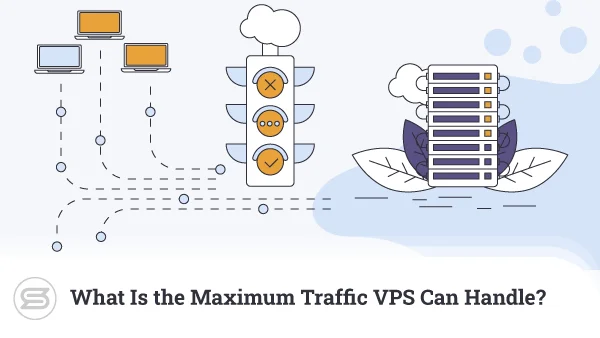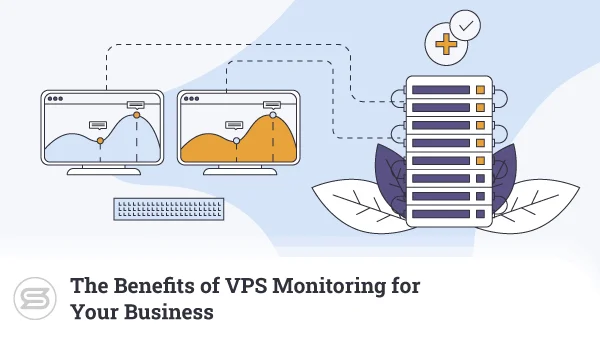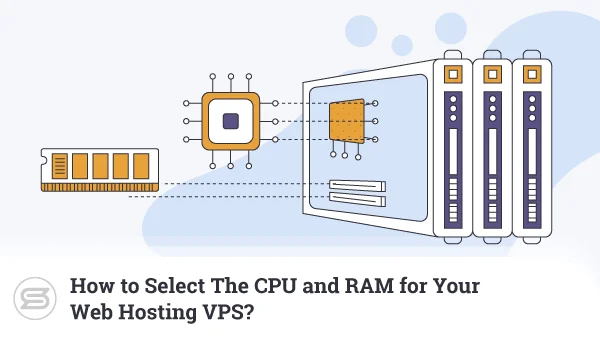What’s the recipe for a successful web or mobile application?
You need to identify the target audience and determine what features people expect to see. Make sure that all the required functionality is present and wrap it in a good-looking, easy-to-use package.
Last but not least, you have to market your app and make it more visible than your competitor products. Before you start thinking about all this, however, you need a solid platform to step on.
No matter how great the app is, people will only engage with it if it’s quick and responsive. And the only way to ensure it’s running at optimal speeds is to develop and host it in the right server environment.
Today, we’ll show you why a managed VPS hosting service is a prime candidate for the task.
Introduction to Managed VPS Hosting for App Development
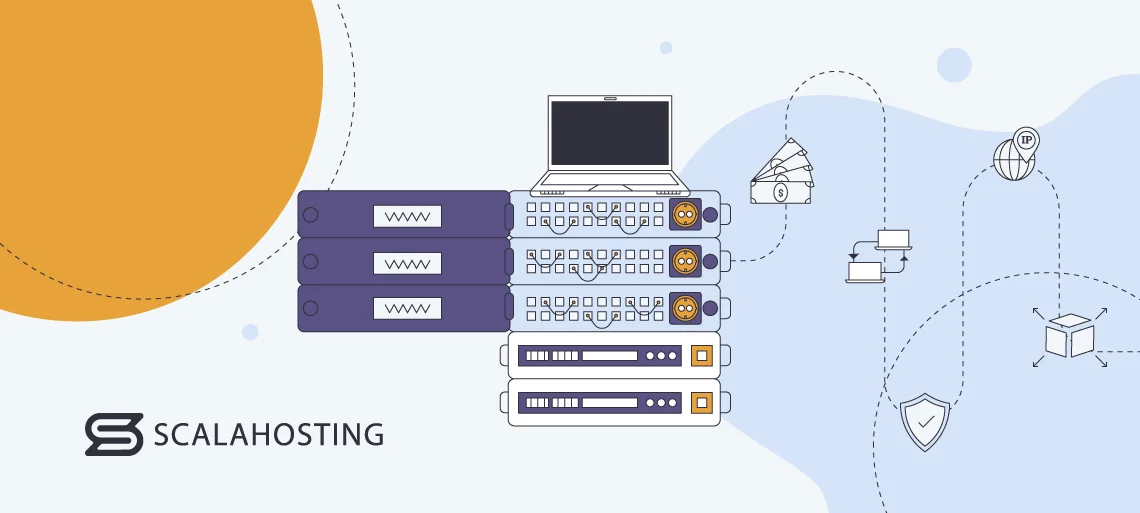
Most of the software you use every day requires an internet connection. This means the app periodically exchanges information with a server.
You can find all kinds of platforms. Even your home computer can act as one, though using it as a hosting server is not a very good idea, as it will never provide the speed you’re after.
Shared hosting won’t do the trick, either, and there are more than a few reasons for this. First, hundreds of accounts reside on the same physical machine. At any given time, you’re sharing the server resources and its IP address with many other apps and websites. The setup can’t give you the consistent performance you’re after, and the fact that multiple people use the same server inevitably leads to security concerns.
Furthermore, shared plans are optimized for small website hosting only. You can upload files and set up databases, but if you need anything outside the basic stack – you’re pretty much out of options.
So, what you need is a proper server powered by high-end hardware and located in a data center, where it’s maintained by a team of professionals and connected to the internet via a high-speed connection. Hosts can rent you an entire physical server but also offer the so-called Virtual Private Servers or VPSs.
What’s so special about them?
As the name suggests, a Virtual Private Server is a virtual machine explicitly reserved for your project. You get:
Remote access and collaboration with other developers
The VPS resides in the cloud and is accessible anywhere in the world. It allows you to work on the project even if you’re away from home or the office and don’t have your personal computer with you. You can show a client your progress without meeting them in person and form a global team of developers who work on the same app from all corners of the planet.
Guaranteed resources
Every VPS has its own set of hardware resources. The storage space, memory, and processing power included in your plan are available 24/7, meaning consistent performance at all times.
Dedicated IP address
Countless security services try to keep the internet safe by limiting traffic to IP addresses suspected of nefarious activities. Because you are the only one using your VPS IP – you don’t need to worry about its reputation being tarnished by someone else’s actions.
Data security
The security measures you get with your VPS vary from provider to provider and plan to plan. However, if you’re getting a managed VPS solution, you will likely have an environment designed to protect your app and its data. Things like offsite backups are the standard these days, and providers can help you implement other features that will help you keep your app safe to use.
Completely isolated environment
Individual virtual private servers are fully isolated from each other. They work like separate machines, allowing you and your host to modify the environment to your project’s specifications.
Managed VPS hosting ensures that all these advantages don’t come at a high cost. And the benefits don’t just end there.
Setting up and running a virtual or physical machine for web hosting involves some server maintenance tasks that many people might find challenging. With a managed VPS solution, you don’t need to worry about them.
Your provider will deploy the virtual server, install the software stack, and configure everything so it’s ready to go. You can start work on your app without thinking about firewalls, updates, patches, etc. The service is constantly monitored by your hosting support team, meaning you can have a truly reliable and secure server environment without the trouble of building and maintaining it yourself.
Managed VPS hosting presents a compelling case, but some of you may have already started wondering why hosts advertise virtual servers instead of simply renting out their physical machines.
The truth is, you can still find dedicated servers, but their popularity is well and truly waning. That’s because modern VPS solutions are much better in two key aspects.
Scalability and reliability
Modern VPS solutions are deployed on a cloud infrastructure, which gives them a massive edge over the traditional dedicated servers.
You see it when you need to upgrade your virtual machine. You can add another CPU core, expand the RAM, or increase the storage capacity with a couple of clicks – no need to move files and databases, redirect domains, or reconfigure applications. At worst, you’ll have to reboot the VPS server, which usually takes a minute or so.
Furthermore, because the cloud your VPS resides in consists of multiple nodes connected in a giant network, the pool of hardware resources it can tap into is pretty much unlimited. In the past, dedicated servers used to be the most powerful form of hosting, but modern cloud technology means that a VPS can easily outperform a dedicated machine.
Managed VPS plans also excel in terms of uptime. A cloud VPS is supported by multiple interconnected nodes, meaning it doesn’t have a single point of failure. In case of a hardware fault in one of the nodes – the virtual server can automatically be redeployed on another machine and brought back online quickly.
By contrast, if there’s something wrong with your dedicated machine, your app goes down with it.
Price
The margins are pretty tight during the initial stages of any app’s development, and because your reach is still relatively limited, you don’t need a particularly powerful hosting package. You definitely want to avoid paying premium prices. Dedicated servers don’t have much of an answer to your questions.
Even the cheapest dedicated machines come in at well over $80 per month and present spec sheets that aren’t that impressive. Some even offer HDD storage, which is antiquated technology in the web hosting world. These machines can never be a viable long-term solution.
VPS hosting is a much more flexible service. Those of you building a simple utility app can opt for an entry-level VPS with a couple of CPU cores and limited memory and storage.
Prices start at around $15 per month if you opt for a longer billing cycle, and you can upgrade whenever and however you want. You’re not even confined to fixed plans on a proper cloud infrastructure. You can add CPU cores, upgrade the RAM, or expand the storage without changing the entire configuration. This way, you can ensure you’re not paying for resources you don’t need.
Overall, while VPS and dedicated servers can act as good app development platforms, virtual machines are by far the better choice. They’re much easier to scale and adapt to your needs, and they’re not only cheaper but more cost-effective than dedicated solutions.
Choosing the Right VPS Configuration for Your App
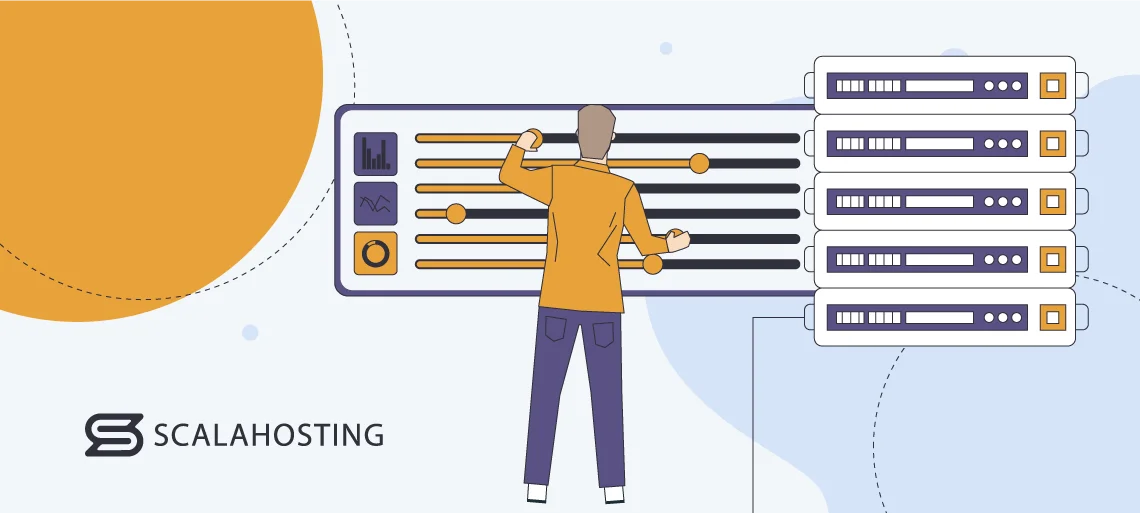
People often adopt a straightforward strategy when choosing the first managed virtual server – they just go for the cheapest option. The reasoning behind such a decision is sound – you don’t need all the hardware resources in the world during the early development stages, and you want to keep the costs down.
However, many don’t realize that their immediate choice plays a significant role in determining the project’s development path. Picking the wrong server at the start could cause delays and other headaches down the line, and the savings aren’t always worth it.
To avoid this, you need to learn more about how a VPS works and how its components and features serve your app. This will help you identify your project’s exact requirements and use them to make an informed decision.
Let’s break it down.
Operating system
The main concern revolves around the range of supported applications and technologies. Some projects may rely on tools only available under Windows, so the direction is pretty straightforward. More likely than not, however, you’ll be better off going for a Linux VPS.
Powering over 90% of the public cloud, Linux dominates the web hosting OS market. Its distributions are considered more stable, and unlike Windows – they are open-source and completely free to use.
There are dozens of Linux distributions to choose from. While based on the same kernel, there are differences in how they handle various software packages, so a bit of research may be a good call.
Access levels
Although the managed VPS is yours to use, there are often restrictions on what you can do. Usually, full root access is only available to your hosting support team, and there’s a very good reason for this.
With a managed server, your host’s technicians configure everything to perform at optimal efficiency. If every VPS owner has root access to their virtual machine, some of them may fiddle with the core settings and undo the work done by the experts.
This shouldn’t be a problem for most users – they will probably be able to build their projects without touching the server’s configuration. However, if your app requires you to install custom software, the lack of root access could be an issue.
Before you sign up for any managed service, ask your VPS hosting provider of choice about the default setup, check whether any changes need to be made, and if that’s the case – figure out who can make them.
Some hosts can give you root access to the managed server upon request, and others can set up the tools you need and make the modifications for you. Whatever the case, be sure your VPS server can give you the optimal app development environment.
Server location
Situating your app server close to your target audience can make a real difference.
The distance data needs to travel impacts loading speeds, and there are ways of reducing it. For example, a Content Delivery Network (CDN) saves file copies on multiple servers around the world and serves data from the location closest to the user.
However, a CDN only works with static files. The dynamically generated elements still need to be delivered by your VPS, so be sure it’s deployed in a data center that is as close as possible to your users.
CPU
The CPU or Central Processing Unit is often referred to as the brain of any computer. Its responsibilities involve a range of tasks, including interpreting and executing instructions, processing data, storing information in the RAM, etc. Your VPS has a predetermined amount of processing power reserved for it. It comes in the form of CPU cores.
The multi-core architecture allows CPUs to handle more processes at the same time. Your VPS powers an app that will hopefully be used by hundreds and maybe thousands of people at once, so it will have numerous connections and tasks to handle simultaneously. That’s why almost every VPS plan has at least two CPU cores.
Unfortunately, deciding whether that’s enough is quite tricky. The number of cores you need depends on both the popularity and complexity of the app. Initially, you’ll want to start small, but if you’re building a multi-layered app with tons of functionalities, it’s best to add more cores early on. Be sure you plan your budget accordingly.
RAM
Your server’s Random Access Memory is a temporary storage device reserved for data that must be easily accessible. This data is generated by both the users and the app itself, and if it exceeds the server’s capacity – the negative effects on the performance will be visible. Getting a VPS with sufficient RAM is the only way to avoid this.
VPS solutions at the cheaper end of the scale usually come with 2GB of RAM. Provided you’re not developing a super complex application, this may be enough to sustain your project during its development phase.
After the app goes public, however, consider adding more memory to the setup to guarantee excellent loading speeds when traffic levels pick up.
Storage
Figuring out how much storage your app will need should be relatively easy. You need to bear a couple of things in mind, though. First, make sure you factor in the additional data users generate. For example, if you allow people to upload high-resolution photos through your app, you’ll need to leave quite a lot of storage in reserve.
The capacity is not the only thing to consider. The hardware is just as important.
Not that long ago, Hard Disk Drives (HDDs) were the only solution for storing data on a server. They weren’t particularly quick and had many moving parts, making them somewhat unreliable, but vendors just didn’t have an alternative.
Right now, they do – Solid State Drives (SSDs) include no moving parts, and their read/write speeds are much faster than HDDs. This hasn’t stopped companies from innovating, though.
Thanks to a new interface called NVMe (NVM Express), the ante has been raised again, with reading speeds now reaching up to 3500 MB/s. For comparison, a regular SSD peaks at about 550 MB/s, and an HDD reaches 175 MB/s.
SSD drives used to be pretty expensive and had a tendency to fail after a period of intense use. However, the evolution of the technology has prolonged their lifespan and dragged the price down to the point where SSD storage (through the NVM express interface) is the standard you should be looking for when picking your VPS.
Bandwidth
Bandwidth is the maximum volume of data your VPS can serve over a particular period. Data consumption has skyrocketed in recent years, and internet connections are much faster than they used to be. As a result, hosting providers are flexible with data transfer limits and their enforcement, with some even advertising plans with unmetered bandwidth.
The truth is, bandwidth shouldn’t be a problem initially, but as you start drawing more and more users – you’ll need to keep an eye on it. If you exceed your host’s limits, your app will stop working, so you must avoid this at all costs.
The number of users and the app’s complexity are just two of the many factors determining how much speed and reliability you can expect from the server. Choose the right platform from the start, and it will all come down to monitoring your application’s performance and upgrading your VPS whenever you see a drop in loading speeds.
However, before we get to that point, you have a more pressing task – developing the app. Let’s see how you do it on your managed VPS.
Remote Development and Accessing VPS Servers
Having your own server is all well and good, but you need ways of managing the data hosted on it. There are three main methods for accessing your server from your computer.
Control panel
After your VPS has been deployed, your host sends you a welcome email with instructions on creating an account and logging in to your control panel. This is the primary management tool for your VPS service. Usually, it consists of two separate sections – an admin area and a user interface.
The admin area is where you effectively start your projects. From here, you create accounts, add domains, and determine who else can access the server. You can restart active services, modify various security settings, enable or disable different database engines, and alter the hosting environment for individual accounts.
There are many control panels, and your options depend on your managed VPS provider. If you get your virtual server from ScalaHosting, you can use SPanel – our proprietary server management platform equipped with all the tools you’ll ever need to develop your project.
The homepage of SPanel’s Admin Area looks like this:
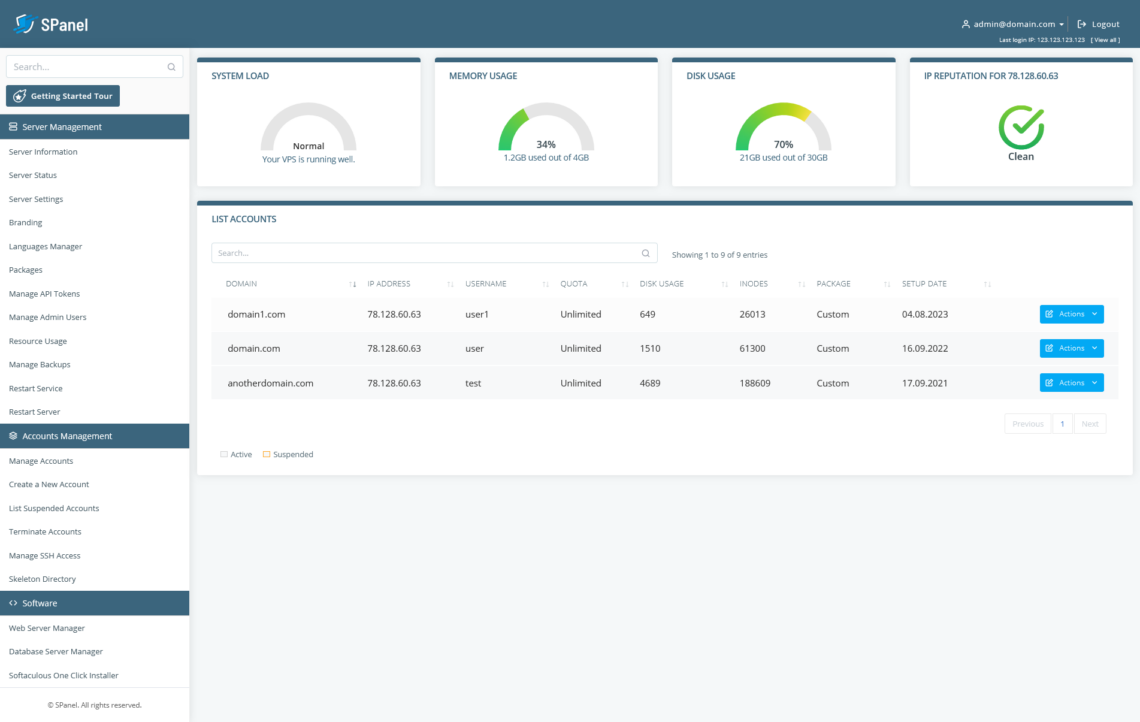
You have the entire virtual server to yourself, so it’s up to you to decide how many projects you’ll host. For every website or application, you have a document root directory for the data and an account granting access to the control panel’s user interface.
If you use SPanel, it looks like this:
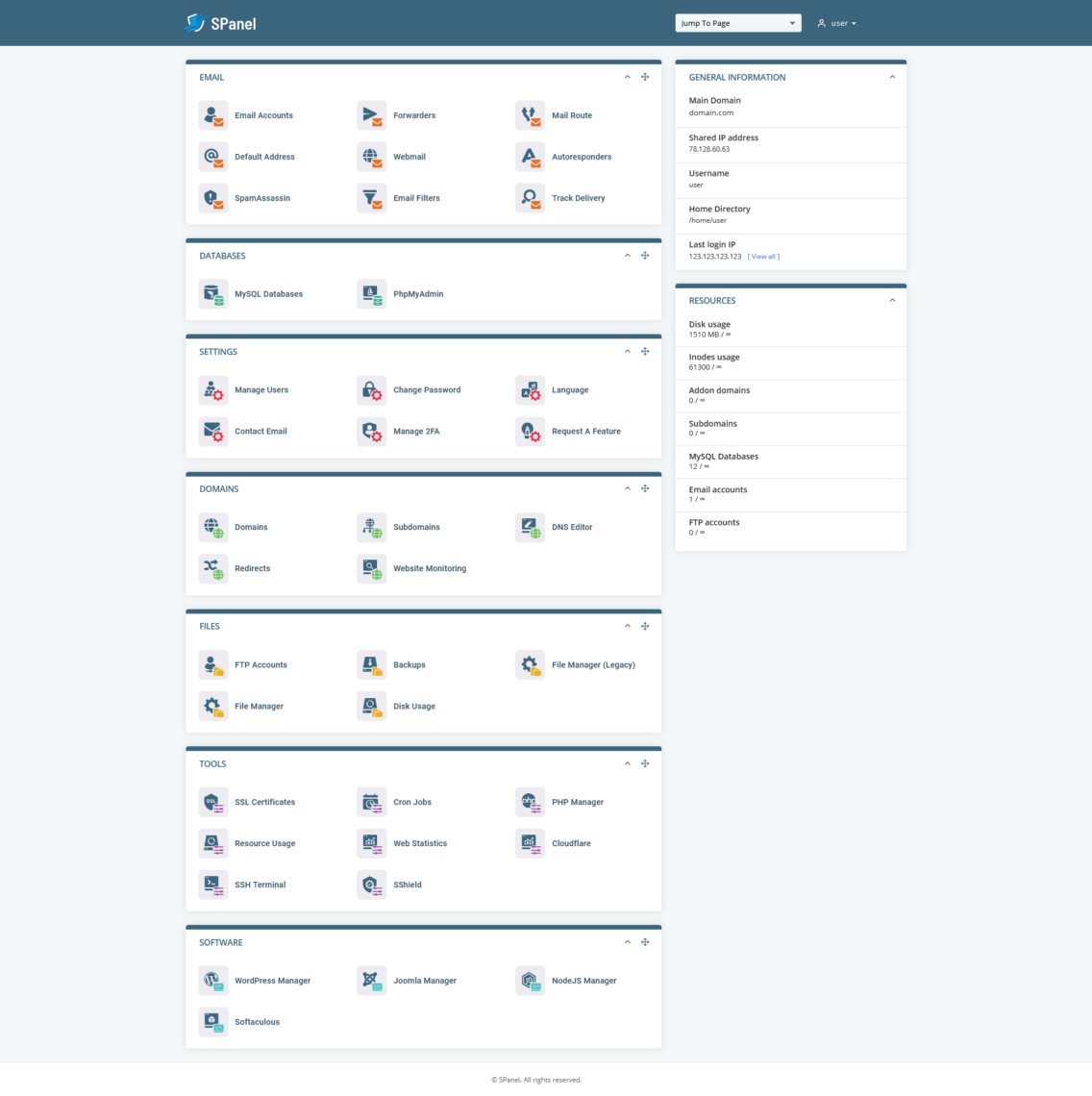
Through it, you can set up email inboxes, create databases, manage domains, subdomains, and DNS settings, back up data, set up an SSL certificate, etc.
Most control panels also offer a File Manager for uploading and managing files and directories. However, it could be faster when handling large volumes of data. That’s why most people prefer the protocol we’ll discuss next.
FTP and SFTP
FTP stands for File Transfer Protocol, and although it’s now over 50 years old, it continues to be the most popular way of uploading data to a remote server. It has become the standard, but its age has started to cause some security concerns.
FTP transfers the data as-is. Files are not protected in transit, so theoretically, anyone can intercept and steal them. That’s why, in 1997, SFTP was introduced by the Internet Engineering Task Force – the organization responsible for standardizing the technologies we use to connect to the internet.
SFTP stands for Secure File Transfer Protocol, and unlike FTP, it transfers the data through an encrypted tunnel. Despite its name, it’s an entirely different technology, built from the ground up as a replacement for FTP.
Using SFTP is similar to connecting to a server via the old protocol, though.
If you use FileZilla, for example, you just need to enter “sftp://” before your server’s IP in the Host field. SFTP uses port 22 by default, but some hosts change it for security reasons. If your provider has opened a custom port, you’ll have to specify it in the respective field.

SSH
SSH stands for Secure Shell, and it’s a cryptographic network protocol that does what it says on the tin.
The Shell in “Secure Shell” stands for the name of the command line interpreter in Unix-based systems. Through it, you execute commands on the remote server from your own computer.
You can install applications, set up server-side scripts, and configure your VPS’s core settings. In other words, it plays a critical role in customizing your hosting environment to your exact specifications.
The only limiting factor is the privileges your host gives you. If you have root access, you’re in complete control of the server. If not, there will be certain limitations related to the core server configuration and the installation of third-party software.
The Secure in “Secure Shell” guarantees you can do all this without worrying about anyone interfering with your commands. SSH relies on a robust cryptographic algorithm to securely encrypt the client-server communication. The protocol has been around for well over 20 years and has proven to be the best way of remotely operating a Unix-based machine.
There are several options for connecting to a server via SSH. You can use a dedicated client like PuTTY. It’s free, works with most operating systems, and is pretty easy to use. You can save sessions and access them with a couple of clicks.
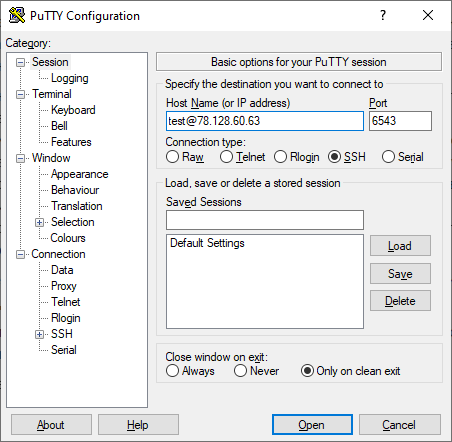
Alternatively, you can use your operating system’s own command-line interface. All modern desktop OSs support SSH out of the box, so you can use the Terminal in Linux or macOS and either PowerShell or Command Prompt if you have a Windows PC.

Setting Up Development Environments on a VPS
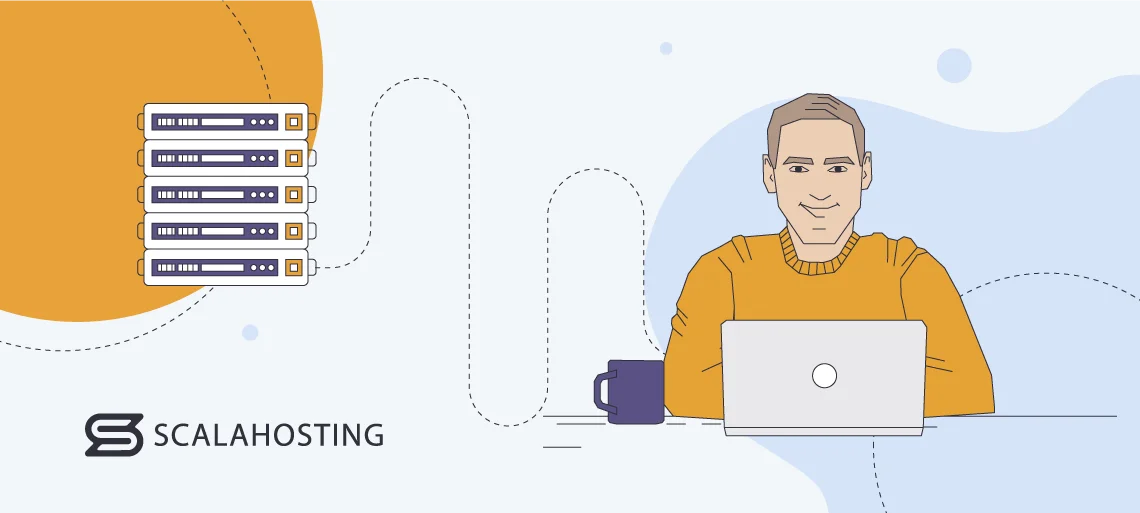
The exact actions required to prepare your VPS for app development depend on the project. However, your first job must be to create a section of your server reserved for your new application.
This means using your control panel’s admin area to create a user account, which establishes a new document root, assigns a domain, and sets up the login details that grant access to the user interface.
Next, you have to set up a space where you’ll test all the changes you make to your app before rolling them out to the public. There are multiple options for creating a staging environment. Some web developers go as far as using a separate VPS for testing purposes. A subdomain with an individual directory on the production account can also do the trick for smaller projects.
With a managed VPS solution, the rest of the prerequisites are in place. Things like the web server, firewall, and database management system are already installed and configured, so you don’t need to waste any time on them.
You need a database, but creating it takes no more than a minute, especially if you do it via your control panel. However, the choice and installation of an IDE require a bit more time.
IDE stands for Integrated Development Environment, and it’s one of the most powerful weapons in an app developer’s arsenal. Traditionally, code is written in standard text editors. Theoretically, you can build the entire project using nothing more than Windows Notepad.
However, modern code development involves a lot more, and if you want to do it efficiently, you’ll need additional tools to help you streamline the process and automate some of the time-consuming tasks.
An IDE knows the programming language even better than you, so it can automatically edit the code you’ve written, apply the correct syntax rules, suggest and auto-complete lines, and restructure the code so that it’s easier to read and understand. It also automates large parts of the code compilation, testing, and debugging processes.
There are two main types of IDEs:
Local IDEs
With a local IDE, the code editor and the rest of the tools are installed on your computer. The primary advantage is that you don’t need an internet connection to work on your project.
On the flip side, local IDE platforms are fairly resource-intensive, so you’ll need a powerful device. Furthermore, once you create the app on your computer or laptop, you’ll have to upload everything to your VPS, and any differences between your local configuration and the one on your server could result in errors.
Cloud IDEs
With a cloud IDE, you write and edit code straight on the VPS. It’s accessible via a browser and brings a whole heap of advantages.
First, your VPS is far more powerful than your personal device, so resource-intensive tasks like compiling and debugging code will be dealt with much more quickly. Second, since all you need to access a cloud IDE is a browser, you can use any device you want, regardless of size or operating system. Last but not least, with a cloud IDE, you write the code, test it, and deploy it on the same system. There’s no risk of configuration discrepancies wrecking your work.
Since you already have a managed VPS service, choosing a cloud IDE for your project makes more sense. However, as soon as you start looking for one, you’ll see there are quite a few to pick from.
The array of options can be overwhelming, but if you are meticulous in your approach, you’ll quickly sift through the platforms and eliminate the unsuitable ones.
Here are the factors you need to consider:
- Supported programming languages
Different IDEs support different programming languages. Your first job is to shortlist the ones that will work for your project.
- Self-hosted IDE or SaaS IDE
Some IDEs are software packages you install (full root access is often required) on your managed virtual private server before you can open the code editor via a browser. Others are offered under the Software-as-a-Service (SaaS) model – you sign up and log in at the vendor’s site, configure the IDE to pair with your VPS, and start your work. The different approaches affect your workflow, collaboration options, and resource usage, so considering the pros and cons, it is a good call.
- Performance within your operating system
Most self-hosted IDEs have multiple versions catering to different operating systems. However, sometimes, even if an IDE works on all OSs, its performance isn’t the same across the board. Do some research and determine whether the ones you’ve picked will work well in your hosting environment.
- Features
A modern IDE is more than a mere code editor with an intuitive interface. It has to be a comprehensive solution that helps you with every aspect of the app development process. This includes testing, version control and integration of platforms like GitHub, packaging, continuous integration and deployment (CI/CD), and many more. Look at the IDE solutions that fit your requirements, and pick the one with the most complete range of features.
- Price
Some IDEs are proprietary products and are fully paid, usually under a subscription model. Other solutions offer a free version but lack some features and the bells and whistles of a paid platform. A third option is to use an open-source IDE. Quite a few of them are available, and they can save you a lot of money, especially during the early stages of development.
Conclusion
Finding the best server infrastructure to support you through your project’s development process can be challenging. On the one hand, you’re looking for a powerful solution to provide your app with the performance you’re after. On the other, the environment must be flexible and easily adaptable to your project’s needs and growth.
It’s a tricky combination to find, and of all the available options, managed VPS hosting is the only one that can deliver on all fronts. You just have to find the right package.
FAQ
Q: Should I choose managed or unmanaged VPS hosting?
A: Unmanaged or self-managed VPS hosting is suitable for experts and sysadmins who have the time and inclination to handle all the complex server maintenance tasks themselves. With it, users get access to a virtual server with just the operating system installed and pretty much nothing else. It’s up to them to set it up and configure it to their own liking.
A managed server is pre-configured by your host’s technical team, making it more suitable for the average user. The experts can set everything up for the best possible performance and security and maintain it while you focus on building your project.
Q: What is the best operating system for my VPS?
A: Linux powers the vast majority of virtual and dedicated hosting servers. The open-source operating system often provides the best environment for web and app development, and it’s likely to work with your project as well.
Nevertheless, check your app’s requirements and see whether it needs a technology solution that will only work under Windows or macOS. VPS servers using these two OSs are also available if that’s the case.
Q: How do I choose a good VPS provider?
A: Some of the things you need to look for in a good hosting provider include a reliable cloud infrastructure for the deployment of the servers, an intuitive control panel for managing it, an extensive set of features that help you build your app, and a customer support team ready to answer any questions you may have. You have many VPS hosts to pick from, so make sure you choose wisely.

